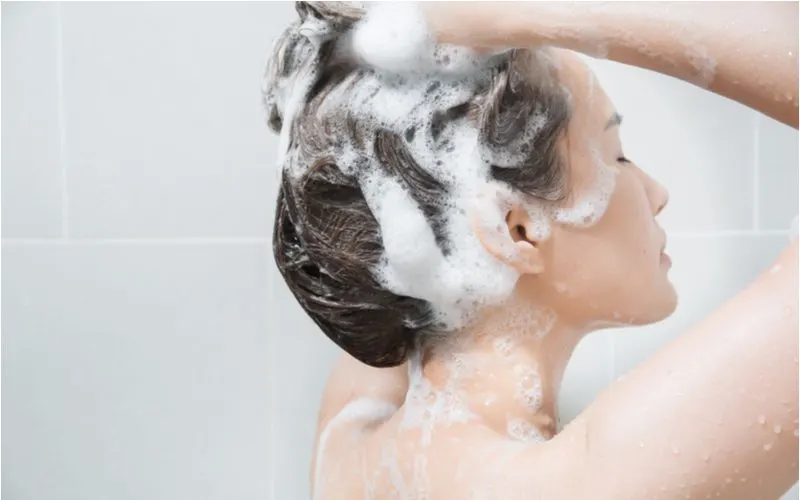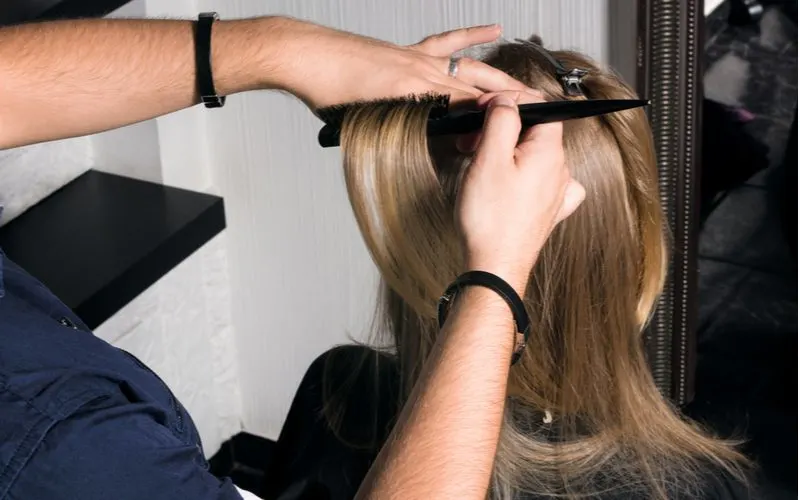Jump to:
Want to learn how to tease hair? You’re in the right place. But before you start backcombing your ‘do, there are some things to consider to ensure you end up doing it properly. Read on to learn the steps to take, things to consider, and the best products to use.
How to Tease Hair: A Summary
Gather the right tools and materials, and then wash and dry your hair. Next, follow these steps:
- Prepare your hair
- Tease your hair
- Style your teased hair
Read on to learn how to tease and add volume to your hair, just like a pro.
How to Tease Hair in 3 Easy Steps
Teasing hair is relatively easy, especially if you follow all the steps correctly. Let these tips guide you to getting the perfect teased style out of your hair.
Step 1: Hair Preparation

Sahacha Nilkumhang/Shutterstock
While you can tease dirty hair, previously styled hair, and bed-head hair, it’s always best to start with clean, dry hair. Shampoo your hair thoroughly with a high-quality volumizing or light moisturizing shampoo. Avoid shampoos with deep moisturizers or oils as this can fight the tease. These shampoos are designed to make your hair sleek, smooth, and tangle-free, which is the exact opposite of what you’re going for.
You can also use a dry shampoo here instead of the regular one. If you choose to use dry shampoo, apply it to the roots. It helps with freshness and adds volume to your hair.
After shampooing your hair, you can skip the conditioner because it softens hair and smooth hair may fail to hold the teased texture. If your hair is dry and cannot do without conditioner, apply it only to the ends. Doing so will eliminate the dryness and keep the hair teased.
Now, it’s time to dry your hair — completely. Whatever you do, make sure that your hair is thoroughly dry before teasing, since teasing it while it’s still wet or damp could damage it.
Blow-drying adds volume to hair, so this is a great time to lay the foundation for your style. Try focusing on the root area while drying and begin to style your hair in the direction you want it to lay.
Don’t skimp on the products either. Using a volumizing product, such as mousse, can help add volume. Apply it before drying your hair to get the desired effect.
The last part of preparing your hair is brushing out the tangles. Pay attention to the type of comb you’re using to avoid unnecessary breakage. You can choose between a paddle brush and a wide-toothed comb to detangle. Work your way from the ends towards the root so that you don’t pull any hair out. Removing tangles makes teasing easier.
Step 2: Actual Teasing

Kirill Shashkov/Shutterstock
After preparing your hair, you are ready to start teasing it. Start by carving out and holding a half-inch section of hair straight out from your scalp at the crown (a rattail comb is the perfect tool for this). Make sure that you hold the section taut away from your head. Place the teeth of the comb into the underside of the section, about three inches away from the scalp. Push the comb down towards the scalp. You should see a cushion of hair start to form. This is the tease.
If you don’t want to use a rattail comb or teasing comb, you can also use a boar bristled brush.
When teasing the sectioned hair, comb it towards the scalp three times. Keep creating sections and adding tease in all of the areas you want to achieve fullness. Afterward, you can proceed to create a bold tease or a simple 80’s hairstyle.
You should always tease your hair gently so that you don’t damage it. Once you’ve teased the first section, clip it at the root after pulling it forward to the front of your head. The goal is to keep the teased hair out of the way while you tease the other sections. Continue by creating sections under the first one and tease them. Then, follow the same steps used in the first section on the rest of the hair.
After teasing all the sections, unclip your hair, and lay it on your head naturally. Next, comb the surface of the areas to achieve smoothness, taking care not to undo the frizz.
If you have hair spray, you can spray it over the teased areas to help hold the hair together for long. That said, be sure to get a spray designed explicitly for teased hair.
Step 3: Styling Teased Hair

Maidannikov/Shutterstock
After you spray your hair with a bit of hairspray, you can continue to refine your style and add accessories if you want. The goal with any styling is to smooth the top of the hair (the part that people see) while maintaining the tease underneath. This can be tricky to do. So, if you notice that you’re pulling the tease out, simply go back in and add it again until you achieve the perfect balance.
You can also lift your hair with a pick or wide-toothed comb to achieve height. You can do this to all the areas of your head with teased hair until your hair looks taller. Another thing you can do is wear it in a ponytail. It works best if you have teased sections of hair at the front center of your head. After teasing, smooth the surface of that section, spray it, and put it in a ponytail.
Any style that benefits from extreme fullness and extra strong staying power is great for teased hair. Classic updos, such as French twists, are a prime example. Use tease to add volume and grip to your favorite styles. Tease is also a great way to fill in thin areas and/or get your hair to stay put when it keeps wanting to fall down.
Getting Rid of Teased Hair
Once done, the next step is to get your hair back to normal. Start by brushing through your hair patiently and carefully. Teasing hair creates knots and matts, both of which you can take care of with a soft bristle brush.
Section your hair into small sections and brush it from tips to roots until you detangle it completely. You can use conditioner to soften up your hair when brushing hair. The trick, however, is to apply it before shampooing.
Keep in mind that teasing your hair doesn’t have to be exclusively for fun. For example, if you have damaged hair, teasing could help add some volume to your hair. And the best thing is that you can still style it to fit your personality.
Things to Consider Doing to Get the Best Teased Style

William Moss/Shutterstock
If you want to make your teased hair match the style that well represents you, consider the following tips:
- Concentrate on the crown and roots: Pay attention to the crown and roots; this will ensure that you get just the right amount of volume in your teased hair in all the right places.
- Use a boar bristle brush or a rattail comb: A boar bristle brush performs better than a comb. Stylists recommend it because the bristles are gentle on the hair. Rattail combs are also relatively safe and easy to use, especially when used properly.
- Prep your hair by adding textures: Prepping your hair is an integral part of teasing. Unwashed hair has the best texture for teasing. However, most people prefer to work on clean hair so far as washing it. It’s essential to get your hair into a condition that makes it easy to work with. Don’t use the conditioner when teasing your hair and avoid using serums and oils that could make your hair slick.
- Start from the bottom up: Teasing hair from the bottom up ensures the top section is flat on top of your nest of hair—section hair into top and bottom layers. The top layer, which contains thin hair, won’t be teased. Let it lay flat against the nest section of hair. Finally, hold and section the top layer and clip it.
- Go section by section: You can choose to tease the back portion of your hair or the sides. First, grab about half an inch wide of hair for teasing. Then, proceed to backcomb hair from about three or four inches from the crown. Comb every section of your hair about three to four times. Then, lay it down before moving to another area. Finish with some hair spray.
- Look for products that enhance the effect. Although you can’t use conditioner on hair that you want to tease, you can still use shampoo. Look into getting a volumizing shampoo. These shampoos have properties that will add volume to your hair, like the name suggests, while protecting it. Besides shampoo, there’s also spray that helps your hair hold in position. The spray is essential if you want your hair to maintain its newly gained volume as well.
- Make a clean finish: After teasing the roots, finish by smoothing the top section over the teased bottom. Comb the top layer gently and spray it. You can get creative with the rest of your hair, like curling it with rollers or putting it in a ponytail. Your new teased hair gives you the freedom to be playful with hairstyles.
So, How Do You Tease Hair Like a Pro?
Learning how to tease is easy, especially when you understand the kind of hair you have. It involves straightforward steps that anyone can follow. If you don’t get it right the first time, it’s better to keep trying until you know how to do it.
